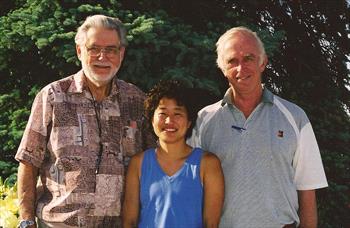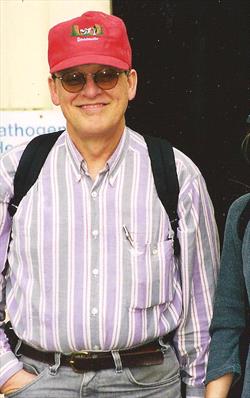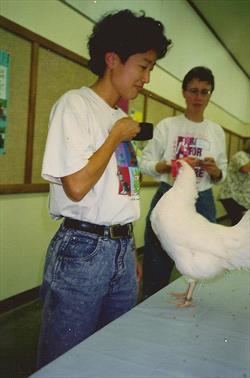Who Most Influences Your Path in Animal Behavior?
Occasionally, someone asks me, “Which trainers had the biggest influence on your career?” This question always makes me stop and think. I have picked up quite a bit from many trainers and then integrated these techniques to devise my own system, but this question makes me pause because, by far, the most important influences on my career are, first, scientists and, second, a few key experiences. Here are a few:
Ray Coppinger
My first experience with Dr. Ray Coppinger (pictured here with Erich Klinghammer and I), whom I associate with the theory of neoteny and self-domestication in dogs, was at Wolf Park in 1999 after I’d been a veterinarian for about five years. He presented several lectures. In one, on genes and behavior, he built up to a climax and then stated in his mischievous way, “There are no genes for hip dysplasia or for behavior.” Then, with a twinkle in his eye, he paused to let his words sink in as we tried to puzzle out a reply. As we sat there, too naïve to figure out what he meant yet gripping our seats as we eagerly awaited the big reveal, he finally went on to explain: there are only genes for proteins or enzymes that affect development and behavior. For instance, a set of genes may determine when and how long a bone develops. If development is slow, the bone may not form fully (such as in hip dysplasia). Or a gene may lead to a less effective enzyme in the pathway that makes a brain neurotransmitter.
Of course, when he pointed this out, all six of my courses in biochemistry came flooding back—enzyme kinetics, protein biochemistry, molecular biochemistry, to name a few. Between veterinary school and my undergraduate degree, I had all the information I needed, but I had just never thought about it in that light.
Anyone who knows Ray knows creating a controversy and then engaging in debate is one of his greatest joys. One of his controversies influenced my Master’s research, which resulted in two published journal articles. While I was taking a graduate class in Acoustic Communication in Animals, I re-read his famous Smithsonian article, Hark! Hark! The Dogs Do Bark…And Bark and Bark, about neoteny and barking in dogs where he concluded that dogs are so tainted by domestication that they behave in meaningless ways compared to their wild counterparts. For example, due to domestication, their vocalizations (specifically barking) must lack specific communication functions. I accepted his hypothesis until a professor pointed out that the arguments supporting the idea that dog vocalization is meaningless are arguments that would not have been made if we were discussing any non-domesticated animal. Instead all of the bark characteristics that Ray used to support his argument that barks are meaningless in dogs are characteristics that researchers have found interesting in other species and which have lead to further study of those animals and their vocalizations. This professor’s reminder triggered what turned out to be my thesis research that showed that dogs actually do have different barks in different contexts and they also have individually identifiable barks. Therefore, barks do the have potential to convey information (even if unintentionally). In turn, the research led to the first scientific articles on barking as vocal communication in dogs published in mainstream behavior journals and continues to fuel others’ research on the topic.
While I don’t agree with everything Ray says, what Ray taught me is that we always should seek to view commonly held ideas in a new light. Questioning what we know, challenging what we have heard, and testing our ideas to see if they hold up is what makes animal behavior a science.
Don Owings
Probably few, if any, dog trainers know Don Owings (pictured to the right) because he’s a giant in another field of behavior—acoustic communication in animals. He was one of my mentors when I was earning my animal behavior Masters. What Don gave me was a sense of the history that led us to where we are in animal behavior today. The field started with Disney-like stories about how animals think and has since progressed to scientists—Konrad Lorenz, Niko Tinbergen, Thorndike, Watson, and others—developing methodical ways to approach the study of behavior. He showed us the path scientific discoveries follow—a landmark study on instinctive behavior where Lorenz had parsed out what is instinct vs. environment, followed by an equally important critique that pointed out that Lorenz’ conclusions weren’t exactly right, that the story was more intricate. The history of discoveries in animal behavior continues in this manner: one researcher makes a remarkable discovery and others build upon it. Rather than rendering the previous study useless, contradictory findings build on it. Don described these discoveries and their history as if they were the stories of his life. Where I might remember the details of an article but would miss some of the major points, Don could always describe the most important messages as if they were his own. This trait led me to always have a tape recorder ready when talking to him in hopes that I could capture his every word and someday develop the same ability to process and explain the information as eloquently as he.
Marian and Bob Bailey
One of the most valuable learning experiences for anyone truly serious about modifying behavior in any animal is the operant conditioning camp (a.k.a chicken training camp) taught by Bob Bailey. Luckily for me, I was able to take all three operant conditioning (a.k.a chicken training) camps back when both Bob and Marian were teaching them over a decade ago. In camp, we trained the animals to do some cool stuff—peck a ping-pong ball, peck bowling pins in the right order, run an obstacle course… and more. What I got out of camp gave me more than learning how to train animals to do a few tricks. It provided the direct link from the works of B.F. Skinner and academic learning to applications that could be used in behavior modification on a day-to-day basis. I began to understand how to systematically work towards training goals by making plans, measuring results, then going back and figuring out where to improve. For 47 years, that’s what Marian and her first husband, Keller Breland, and later, Bob Bailey, at Animal Behavior Enterprises did. They trained over 140 species of animals. In their business, they trained up to 1,000 animals a day for shows, commercials, research, and military operations. No individual or organization today can compare to what they did. Their goal was to pass this practical ability on to others. They also shared what they had learned in a methodical way, giving us the potential to do the same.
Applying the Principles to New Animal Behavior Projects
Armed with information from those who had mentored or taught me, I viewed this knowledge as precious, something to dwell on, savor, and learn to apply on a daily basis. However, I didn’t truly appreciate the power and importance of some of these teachings until I worked on the research to develop the Treat&Train® Dog Training System with the Sharper Image Company. This system trained dogs to run to a rug and lay calmly and happily in the face of high-level distractions such as visitors coming to the door. There’s nothing like really testing your ability by trying to come up with a scientifically proven and publishable training program where dogs must complete each step of the training within 10 trials and the overall rate of correct trails must be over 90%, while knowing you need to find the answer within just months or your money will run out.
All studies seem simple until you actually have to plan and carry them out. What I quickly found is that training individual dogs using modifiable protocols based on what I’d seen in the past is very different from developing one protocol that consistently trains a variety of dogs whom you have selected specifically for their difficult behavior. The protocol I used was very different from the ones I had used previously on individual dogs. What I also quickly found, during the clinical trial, was that finding a way to convey the techniques to pet owners was as big a barrier as coming up with a great stepwise program for the dogs. We had to test the owners on the instructions and see what they did in order to determine how to change the instructions until they stopped making mistakes.
This research defined my approach to all behavior cases, training classes, and publishing projects afterwards. It taught me how necessary data are to test an actual training protocol; the actual instructions must be tested on regular people, too.
I approached my books, such as Low Stress Handling, its DVD and other projects, too, using data to test the training protocol for animals and the instructions for the owners. For the Low Stress Handling book, I wrote photo-illustrated instructions plus taking hundreds of hours of video to analyze what handlers were doing correctly and incorrectly and then revising what I had in order to eliminate mistakes. This is the general process of all of my projects.
What I’m Up to Now
Now, our most current project is about finding ways to make behavior consults and recording data more efficient and to collect data that objectively measures trainer technique and owner progress so that we can keep records and to quickly speed owner learning. (To read more about techniques, read Are Head Collars on Dogs Dangerous or Safe, Dog Training is a Technical Skill, and Dealing with Difficult Dogs at the Vet) Owners benefit because they can see how the various exercises are broken down to specific aspects of technique, just like a sport. Dogs benefit because finally they can understand what their human wants. Behavior consults benefit because we can parse out factors of the dog’s personality or current behavior and owner technical ability that are important in predicting which owners are more likely to be successful or act as markers to tell us where the owner is falling short.
All of My Experiences and Knowledge Become Have Shaped All Aspects of My Work
The scientists with whom I’ve studied and the projects I’ve performed have shaped every aspect of my work: writing blog and magazine articles from a unique perspective, creating educational materials that help adults and kids empathize with the animal, developing DVDs, lecturing, and writing books. The knowledge I have gained and that I gain every day is what keeps my career interesting to me and helps me convey key messages about animal care and behavior to others. While the path to obtaining this knowledge was no-cake walk, it was and continues to be more valuable than gold.
Check back for more articles on the experiences that helped shape my career and techniques!





